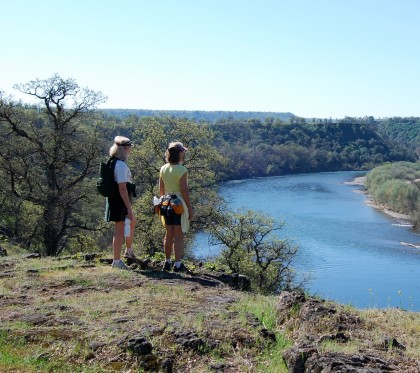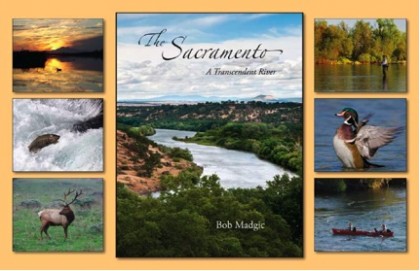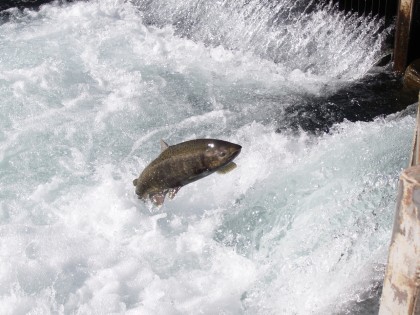A stunning new book written by Anderson resident Bob Madgic gives historical, poetic, narrative, and photographic homage to that stirring flow of water that defines our region in so many ways: the Sacramento River. Bob is sharing about his book first on A News Café.
Could you introduce yourself briefly to News Café readers? You and your wife, Diane, have lived in the north state nearly 20 years. Tell us a little of your personal and professional background and your involvement in this region.
My wife, Diane, and I moved to the north state in 1995. I was retired from a career in public education in the Bay Area. Diane continued her work as a dietitian up here at Mercy Medical Center, fully retiring only a couple of years ago. What brought us here was the Sacramento River. I initially thought I could never leave the Bay Area, until the moment I envisioned a home on water. That vision was sealed with a canoe trip down the Sacramento through Redding. Diane, although not a fly fisher as I am (my prime motive for moving here), nonetheless is a lover of the outdoors.

Fly fishing on the Sacramento River was the main draw for Bob’s decision to move to the north state. Photo by Diane Madgic
I became aware of you when I read your 2007 book Shattered Air, a compelling in-depth account of a tragic Half Dome hike in Yosemite National Park in 1985. (For those familiar with books like Jon Krakauer’s Into Thin Air, or Sebastian Unger’s Perfect Storm, Bob’s account of this true incident offers the same kind of detailed accuracy and research packaged in a gripping story-telling narrative format.) Was that your first foray into book writing?
I began writing as soon as I left college and entered public education in the early 1960s. I had several high school history texts published. But it was only in retirement that I took up writing on conservation, fly fishing, and the outdoors—my life’s passions. This avocation first developed as a means to find productive ways to spend my time, and to continue to educate. My initial effort was a book detailing my outdoors ventures over decades, titled Pursuing Wild Trout. A Journey in Wilderness Values. It was followed by A Guide to California’s Freshwater Fishes, and then Shattered Air.
Your newest book, The Sacramento: A Transcendent River, comes out March 1 (disclosure: I had the privilege of helping edit the volume last year). I found myself fully engrossed in the descriptions, details and history you combined to tell the story of this impressive body of water. Why did you decide to write about the river?
The Sacramento River is one of the most important rivers in the world, yet amazingly no book has been published on it with two minor exceptions: one is The Sacramento. River of Gold by Julian Dana, published in 1937. The second is The Sacramento River by Oscar Lewis, published in 1970 for young adults. The cover of the latter shows Shasta Dam and Shasta Lake! So clearly there was a need to tell the story of this river, especially since many of the most pressing issues in California and beyond involve it. My book is the first comprehensive publication on the river, covering the headwaters to the estuary, and its human history from before Euro-Americans arrived to the present.

Hikers enjoy the river scenery along the Yana Trail in the Bend Area near Red Bluff. Photo by Bob Madgic.
You’ve mentioned your passion for the Sacramento River and your love of fishing. What else made you feel qualified to write such a comprehensive book on the river? (This 224-page volume also covers the dams and mining projects that have forever transformed the river, the decline of the Delta and salmon, conservation and restoration efforts, birds and other wildlife, and much, much more.)
I have long been concerned that so many treatises on environmental issues are written by scientists, government authorities, and the like. While such documents may present the most relevant research and information, they are usually not written for a general audience. I believe that my background as an educator gives me exactly the qualifications needed to produce a book that makes historical and ecological matters accessible and engaging for a broad audience. The intent of this book is not only to inform, but to inspire, and that’s something an educator strives to do.
What did you learn about the river in researching and writing this book that you did not know before?
The Sacramento River, like most rivers in the country, has been severely degraded, whether from dams, diversions, and levees, or from pollutants being dumped into them. The gold rush and other mining operations were especially destructive of California waterways, many carrying their poisons into the Sacramento, which is the primary waterway for the entire watershed. The subtitle for my book, A Transcendent River, is meant to convey how the Sacramento has overcome such devastating abuses. Of course, all this is well known, but still the magnitude of the devastation, as with that from copper mining in Shasta County, was an eye opener. And I did not realize that the Sacramento Valley, which has been a bird paradise for eons due to the extensive wetlands—among America’s largest at one time—was thoroughly drained due to the construction of levees that kept the river from meandering and overflowing. So all of the wildlife refuges along the river today that sustain bird populations and that I cover in the book have to be artificially flooded and managed. I did not know this.
The book is filled with dozens of stunning photographs. How many of those did you take? What do you want the photographs to bring to the experience of the book?
The main theme of the book is the power and beauty of a natural river. The photos powerfully illustrate this theme. They are meant to evoke a visceral reaction, prompting the reader to conclude, yes, such gifts of nature are special and must be protected. I did draw upon the photos of many outstanding photographers. I am highly pleased to find that almost a third of the photos in the book are ones I took, not because I am a good photographer but because it’s hard to miss taking a great photo along this river if you’re in the right place at the right time with a good camera.
The river takes on many personalities in your book – from fish habitat to sacred Indian dwelling to steamboat passageway to recreational mecca, and much more. How have you found yourself relating to the river during your time on or near it?
My main love in the natural world is for streams and rivers. I speak to this extensively in the book’s prologue—the deep feelings that I have for this river and the wildlife it supports, as well as how it provides us humans with enormous rewards. I find nothing more rewarding than standing in the water with the current pushing against my legs, as I cast a fly trying to get one of the Sacramento’s spectacular rainbow trout to strike it.
What do you hope the reader will take away from this book?
What I hope the reader gains from this book is a profound appreciation for the many manifestations of life that a river like the Sacramento sustains. And that the wellbeing of humankind is tightly connected to the health of the river and the myriad of wildlife dependent on its nourishment. We should discontinue compromising its essential character, like raising Shasta Dam and thus inundating more natural habitat. Again we are hearing the same dishonest messaging: “Raising the dam will improve the fishery.” We have heard this message repeatedly throughout the history of dam building. It wasn’t true then, and it’s not true today. Just look at how the Clair Engle Dam (now Trinity Dam) almost destroyed the wild salmon and steelhead fishery in the Trinity River. To the degree possible, let nature be.
To order a copy of The Sacramento: A Transcendent River, email bmadgic@charter.net, or call (530) 365-5852. By late March, the book will be for sale in places such as Turtle Bay Exploration Park (which occupies a key place in the book), Enjoy the Store, Lisa’s Book Nook, Barnes & Noble, and other north state booksellers.
Bob will be speaking to the Shasta group of the Sierra Club in Redding on March 1 and to the River Exchange in Mount Shasta on March 21. If interested in having him make a group presentation, call or email him.
 Candace L. Brown has been a newspaper and magazine reporter and editor for 20 years. She lives in Redding and can be reached at candace.freelance@gmail.com.
Candace L. Brown has been a newspaper and magazine reporter and editor for 20 years. She lives in Redding and can be reached at candace.freelance@gmail.com.






